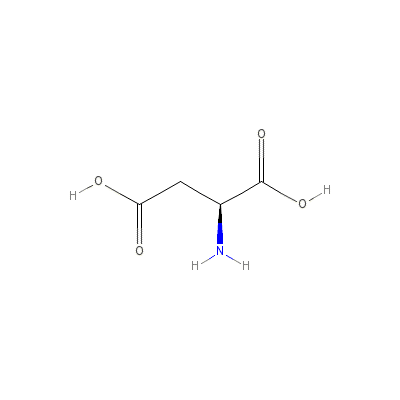(S)-Aspartic acid




(S)-Aspartic acid Brand names, (S)-Aspartic acid Analogs
- (+)-Aspartic acid
- (2S)-Aspartic acid
- (L)-ASPARTIC ACID
- (S)-Aminobutanedioic acid
- (S)-Aspartic acid
- 4-04-00-02998 (Beilstein Handbook Reference)
- AI3-04461
- Acide aspartique [INN-French]
- Acido aspartico [INN-Spanish]
- Acidum asparticum
- Acidum asparticum [INN-Latin]
- Aminosuccinic acid
- Asparagic acid
- Asparagic acid (VAN)
- Asparaginic acid
- Asparaginic acid (VAN)
- Asparaginsaeure [German]
- Aspartate
- Aspartate, L-
- Aspartic Acid [USAN:INN]
- Aspartic acid
- Aspartic acid (VAN)
- Aspartic acid, L-
- Aspatofort
- BRN 1723530
- Butanedioic acid, amino-, (S)-
- CCRIs 6181
- EINECS 200-291-6
- FEMA No. 3565
- H-Asp-OH
- HSDB 1430
- L( )-Aminobernsteinsaeure
- L-(+)-Aspartic acid
- L-2-Aminobutanedioic acid
- L-Aminosuccinic acid
- L-Asparagic acid
- L-Asparaginic acid
- L-Asparaginsaeure
- L-Asparaginsyra
- L-Aspartic acid
- L-Aspartinsaeure
- NSC 3973
(S)-Aspartic acid Brand Names Mixture
- No information avaliable
(S)-Aspartic acid Chemical_Formula
C4H7N1O4
(S)-Aspartic acid RX_link
No information avaliable
(S)-Aspartic acid fda sheet
(S)-Aspartic acid msds (material safety sheet)
(S)-Aspartic acid Synthesis Reference
No information avaliable
(S)-Aspartic acid Molecular Weight
133.104 g/mol
(S)-Aspartic acid Melting Point
230 oC
(S)-Aspartic acid H2O Solubility
4.5 g/l
(S)-Aspartic acid State
Solid
(S)-Aspartic acid LogP
-0.67 +/- 0.36
(S)-Aspartic acid Dosage Forms
Capsules and powder
(S)-Aspartic acid Indication
There is no support for the claim that aspartates are exercise performance enhancers, i.e. ergogenic aids.
(S)-Aspartic acid Pharmacology
L-aspartate is considered a non-essential amino acid, meaning that, under normal physiological conditions, sufficient amounts of the amino acid are synthesized in the body to meet the body's requirements. L-aspartate is formed by the transamination of the Krebs cycle intermediate oxaloacetate. The amino acid serves as a precursor for synthesis of proteins, oligopeptides, purines, pyrimidines, nucleic acids and L-arginine. L-aspartate is a glycogenic amino acid, and it can also promote energy production via its metabolism in the Krebs cycle. These latter activities were the rationale for the claim that supplemental aspartate has an anti-fatigue effect on skeletal muscle, a claim that was never confirmed.
(S)-Aspartic acid Absorption
Absorbed from the small intestine by an active transport process
(S)-Aspartic acid side effects and Toxicity
Mild gastrointestinal side effects including diarrhea. LD50 (rat) > 5,000 mg/kg.
(S)-Aspartic acid Patient Information
No information avaliable
(S)-Aspartic acid Organisms Affected
Humans and other mammals














